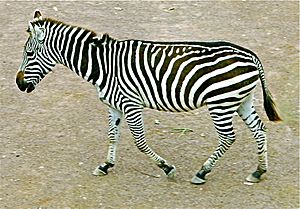Quadrupedalism facts for kids

Quadrupedalism is when an animal or machine uses all four of its legs or limbs to move around. An animal or machine that usually stands and moves on four legs is called a quadruped. The word "quadruped" comes from Latin words meaning "four feet." You can find quadruped animals among both vertebrates (animals with backbones) and invertebrates (animals without backbones).
Contents
What's the Difference: Quadruped vs. Tetrapod?
The words 'quadruped' and 'tetrapod' both mean 'four-footed'. However, they have different meanings in science. A tetrapod is any animal that belongs to the group called Tetrapoda. This group includes all animals that descended from a specific four-limbed ancestor.
A quadruped, on the other hand, is an animal or machine that actually uses four limbs to move. Not all tetrapods are quadrupeds. Also, not everything that moves on four limbs is a tetrapod. For example, some machines are quadrupeds but are not tetrapods. Almost all living quadrupeds are tetrapods. One exception is some arthropods, like the praying mantis, which can move on four legs.
Why This Difference Matters in Evolution
Understanding the difference between quadrupeds and tetrapods is important in evolutionary biology. This is especially true for tetrapods whose limbs have changed over time to do other jobs. For example, humans use their front limbs as hands. Birds and bats use theirs as wings. Whales use theirs as fins. All these animals are tetrapods because their ancestors had four limbs. However, none of them are quadrupeds today. Even snakes, which have lost their limbs, are still tetrapods.
Human Quadrupedal Movement
Sometimes, moving on all fours is called "crawling." You often see this in babies. They crawl on their hands and knees before they learn to walk upright.
Crawling for Exercise and Speed
In the 20th century, moving like a quadruped became a popular form of exercise. A Japanese athlete named Kenichi Ito is famous for running very fast on all four limbs.
The Ulas Family: Unique Human Quadrupedalism
In 2005, scientists found five siblings in rural Turkey who naturally walked on their hands and feet. Unlike chimpanzees, who walk on their knuckles, the Ulas Family walked on their palms. This allowed them to keep their fingers flexible.
Robots That Walk on Four Legs
Scientists and engineers have also created robots that move like quadrupeds.
BigDog Robot
BigDog is a stable quadruped robot created in 2005. It was made by Boston Dynamics with help from other groups like NASA's Jet Propulsion Laboratory.
RoboSimian Robot
Another robot, RoboSimian, was made by NASA JPL and the University of California, Santa Barbara Robotics Lab. This robot focuses on being very stable and moving carefully. It has been shown at the DARPA Robotics Challenge.
Pronograde Posture: Lying Down to Move
A concept related to quadrupedalism is pronogrady. This means having a horizontal body posture. Most quadrupedal animals have a horizontal body. However, some animals that walk on two legs, like many birds and extinct dinosaurs, also have this posture.
Some apes, which usually have an upright (vertical) back, might walk on all fours. This is called knuckle-walking, where they support themselves on their knuckles.
See also
 In Spanish: Cuadrupedalismo para niños
In Spanish: Cuadrupedalismo para niños

